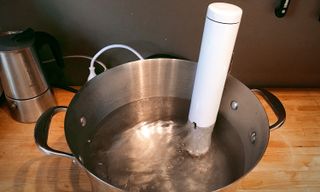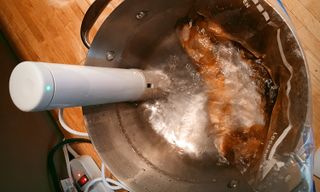ChefSteps Joule Sous Vide Review: A Friendly Intro to Sous Vide
The sleek Joule sous vide machine is easy to use, especially with the video-guided recipes from ChefSteps, but we wish there were more controls on the machine itself.
Why you can trust Tom's Guide

If sous vide cooking — the technique in which you prepare a meal by immersing bag-sealed food into a hot water bath — becomes hugely popular, it will be because devices such as Joule's sous vide machine make it so easy. This sleek $199 gadget connects to an app with video-based instructions from ChefSteps that are so simple to follow, you could practically entrust your child to prepare dinner for the family. And while it's not our top pick for a sous vide machine, there are many reasons why you should consider Joule's sous vide as your next kitchen gadget.
Design
The design of the Joule is simplicity itself; it's a white metal cylinder with an opening at the bottom end and a button with a small LED at the top. The Joule is significantly smaller than the Anova Precision Cooker, our favorite sous vide option. At just 11.8 inches long and 1.8 inches in diameter, the Joule is dwarfed by the 15 x 2.5-inch Anova.

Unlike the Anova, which uses a screw-style clamp to secure itself to a pot, the Joule has a flexible metal clasp. Its rubberized flat bottom is also magnetized, so you don't necessarily need to use the clasp if you're using it with a steel pot. Unfortunately, all of my pots are aluminum, so I turned to the clasp.
Performance
After downloading Joule's app to my iPhone (an Android version is also available), I connected the Joule to my home Wi-Fi network through the mobile app, and got ready to start cooking in minutes.

Whereas Anova partnered with Serious Eats to get recipes, Joule teamed up with ChefSteps, which, in some ways, makes Joule better suited for people who are new to sous vide cooking. That's because ChefSteps' recipes have photos or short videos showing each step of the process, such as properly bagging your food, immersing it in water and then searing it in a pan.
MORE: Cinder Review: This Smart Grill Isn't Well Done
The Joule app also has a searchable database of cooking times and temperatures for a variety of meats, fish and vegetables.

Despite its smaller size, the Joule was just as efficient at heating up a pot of water as the Anova was. That's because the Joule cranks out 1,100 watts, as opposed to the Anova's 900 watts. I easily prepared everything from steak to chicken to salmon using the Joule, and it came out juicy and mouth-wateringly tender.
MORE: 11 Must-Have Smart Outdoor Gadgets
However, during my time using the Joule, there was one thing I really missed. Whereas the Anova has a temperature knob, a display and a start/stop button, the Joule lacks these features; you can control the Joule only through its app.

That's fine for people who are new to sous vide and need app-based coaching, but for those (such as me) who already know that they need to cook sausages at 160 degrees for 45 minutes, having to go through the app becomes a tedious extra step. Plus, it's nice to be able to simply glance at the machine and see that your water temperature is where it needs to be.
Bottom Line
The Joule Sous Vide machine is a great device. It has a sleek look, cooks food efficiently and quickly, and has a very instructive app with videos that make it easy for sous vide newbies to use this cooking technique. However, I still give the edge to Anova's machine for the simple fact that it has a display and the ability to manually adjust the temperature without having to go through its app.
The Joule and the Wi-Fi version of the Anova cost about the same — $199 — but a Bluetooth-only model of the Anova is now just $109. Still, those who get the Joule, especially sous vide newbies, won't be disappointed.
Credit: Mike Prospero/Tom's Guide
Sign up to get the BEST of Tom’s Guide direct to your inbox.
Upgrade your life with a daily dose of the biggest tech news, lifestyle hacks and our curated analysis. Be the first to know about cutting-edge gadgets and the hottest deals.

Michael A. Prospero is the U.S. Editor-in-Chief for Tom’s Guide. He oversees all evergreen content and oversees the Homes, Smart Home, and Fitness/Wearables categories for the site. In his spare time, he also tests out the latest drones, electric scooters, and smart home gadgets, such as video doorbells. Before his tenure at Tom's Guide, he was the Reviews Editor for Laptop Magazine, a reporter at Fast Company, the Times of Trenton, and, many eons back, an intern at George magazine. He received his undergraduate degree from Boston College, where he worked on the campus newspaper The Heights, and then attended the Columbia University school of Journalism. When he’s not testing out the latest running watch, electric scooter, or skiing or training for a marathon, he’s probably using the latest sous vide machine, smoker, or pizza oven, to the delight — or chagrin — of his family.
